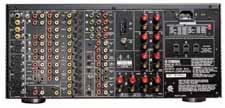Yamaha CDR-HD1300 CD/Hard-Disk Recorder

Most people never see hard-disk drives, but their impact on our lives is becoming universal. We take them for granted, remembering how essential they are only when they occasionally fail. While CDs pretty much own the data of the audio world, hard-disk drives are providing exciting new possibilities. Take Yamaha's CDR-HD1300, for example. This is the second Yamaha CD/hard-disk recorder I've tested. I
reviewed the CDR-HD1000 in the November 2001 Sound & Vision and was so impressed by its innovation that it was one of my Reviewer's Choice Award selections for that year. The CDR-HD1300 can both burn and play CDs as well as record (and play) CD audio without any data compression to or from its internal 80-gigabyte (GB) hard drive, which can store about 120 hours of uncompressed music. The hard drive is removable, so you can swap in a different drive, format it, and store even more music - the owner's manual describes how to do it.
|

As you might expect, the recorder complies with the Serial Copy Management System (SCMS) - in a nutshell, you cannot make a second-generation digital recording. You can, however, digitally copy from an original source (a first-generation copy). Having a hard-disk drive complicates things, because if you copy a CD to the drive, SCMS prohibits you from digitally copying that to a CD - a bummer if you want to put together a compilation on the drive and then burn it to a disc. To get around this, Yamaha provides a Digital Move feature, which digitally copies data from the hard drive to a disc (even if it was previously copied digitally from a source), and then erases the copy left on the drive. Since only one copy of the data is left at the end of the procedure, in the eyes of the "copyright police" it has merely been "moved," not copied.
I spent some time reading the voluminous owner's manual but soon tossed it aside, eager to start ripping. Copying a CD to the hard drive was a piece of cake, and prompts on the front-panel display guided me through it. I loaded Bruce Springsteen's The Rising, pressed copy, then play, and minutes later a clone of the CD resided on the hard drive. I made copies in real time and at 2x and 10x speed (the maximum), then listened to the original and the three copies, switching from one to another.The Rising has some terrifically dynamic tracks, and I'm certain I would have heard any untoward noise or distortion. If there was an errant bit in any of my copies, or if one transfer speed was better than another, I sure didn't hear it. The sound quality of the hard-disk copies was equal to that of the CD, suggesting that the data were indeed cloned. Moreover, both copies proved the mettle of the CDR-HD1300's digital-to-analog (D/A) converters. My finest compliment is that after a while I stopped reviewing the recorder and simply sat there and enjoyed the music.Nevertheless, I verified that the Yamaha's CD-to-hard-drive copying is indeed bit-accurate by making a copy of the DTS CD of Steely Dan's Gaucho. When I fed the copy through the recorder's optical output to an external DTS decoder, it decoded properly, proving that the original bitstream had been copied without alteration. Just for kicks, I then copied the copy of Gaucho to a CD-RW. When I fed that to the decoder, it did not decode properly because the data had gone through a cycle of digital-to-analog-to-digital conversion. But then I moved the data to the CD-RW, and this time it did decode because it had remained in the digital domain all the way (the hard-disk version was automatically erased).Other operations required a little extra button pushing on the front panel or the remote, but my pinkie never broke a sweat - this recorder is easy to use. I copied entire discs or a few tracks to/from the hard drive, copied using analog and digital paths, selected different copy speeds, changed the record level, and copied from external analog and digital sources. I let the deck place track markers automatically and did it manually as well. I also got into the editing mode (on the hard drive), where I was able to erase part of a track, combine a series of tracks, divide one track into two, assign titles to tracks, create fade-ins and fade-outs, and so on (if you've used a MiniDisc recorder, you know how this works). Finally, I appreciated the Undo feature, which let me reverse a previous editing operation.I also experimented with the A.M.Q.R. recording mode. This is not a signal-processing feature - the data are not changed. However, it does change a vital recording parameter in the burner. Standard, or "Red Book," CDs can be recorded with a linear velocity ranging from 1.2 to 1.4 meters per second (the actual setting is up to the master engineer). Among other things, the linear velocity determines how fast the disc spins as data are read. With A.M.Q.R., the velocity is increased, which means that a CD will hold less data than it would with a slower velocity. For example, in A.M.Q.R. mode, a 74-minute CD-R will hold only 63 minutes of music, and a 79-minute disc only 68 minutes. | |
IN THE LAB




























































